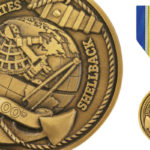On June 6, 1944, the invasion of the beaches of France, famously known as D-Day, included American and Allied forces storming the beaches in hopes of breaching the Nazi’s hold on France. After D-Day the Nazi forces were pushed further east to Paris.
The Invasion of Normandy began with air attacks, glider and parachute landings, and naval bombardments. The next day the famous amphibious landings happened, marking the first day of the Invasion of Normandy.

Divisions that participated in D-Day landings
United States
1st Infantry Division, including, but not limited to, Artillery Battalions, Combat Battalions, Intelligence Corps, a Signal Company, and a Police Platoon
4th Infantry Division, including, but not limited to, Infantry Divisions, Artillery Battalions, a Signal Company, Quartermaster Company, Engineer Battalion, Reconnaissance Troops, Intelligence Corps, and a Signal Company
29th Infantry Division, including, but not limited to, Field Artillery Battalions, Infantry Divisions, a Signal Company. Ordnance Light Maintenance Company. Reconnaissance Troops. Engineer Combat Battalions, and a Military Police Platoon
82nd Airborne Division, including, but not limited to, Glider and Parachute Infantries, Glider Field Artillery Battalion, Parachute Field Artillery Battalion, Ordnance Maintenance Company, Quartermaster Company, and a Signal Company
101st Airborne Division, including, but not limited to, Glider Infantries, Parachute Infantries, Field Artillery Battalions, a Antiaircraft Artillery Battalion, Ordnance and Signal Companies, and Quartermaster and Medical Companies.
On army.mil, there are 214 more divisions, battalions, artillery groups, squads, companies, squads, and combat groups.
Allied Divisions
United Kingdom
3rd Infantry Division
50th Infantry Division
6th Airborne Division
Elements of the 79th Armoured Division
Elements of the 8th Armoured Brigade
Canada
3rd Canadian Division

Medal of Honor Recipients
Private Carlton W. Barrett served with the 18th Infantry, 1st Infantry Division and earned the Medal of Honor by saving his comrades from drowning, carrying injured troops to evacuation boats, assisted the wounded, and calming the shocked. He helped save the lives of many on the beaches of Saint-Laurent-sur-Mer, France, also referred to as Omaha Beach.
First Lieutenant Jimmie W. Monteith Jr. also served with the 16th Infantry, 1st Infantry Division and helped advance his soldiers and tank units through the beach through heavy enemy fire and minefields. With his direction and tactical knowledge, he was able to take out multiple enemy positions.

Technician Fifth Grade John J. Pinder Jr. served with the 16th Infantry, 1st Infantry Division. He was gravely wounded by enemy fire, but despite his blood loss and severe pain, made three trips to the shore’s edge to salvage communication equipment, continuing to risk his life. On his third trip he was hit again in his legs by a machine-gun bullet, but it did not stop him from more trips to save radio equipment. He was wounded a third time and killed.
Brigadier General Theodore Roosevelt Jr. served with the 16th Infantry, 1st Infantry Division, and was responsible for landing the first wave of forces on the beaches of France. He led the first wave of troops, penetrating enemy-held beaches across France.






